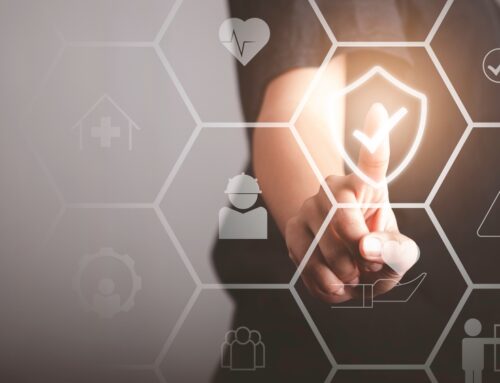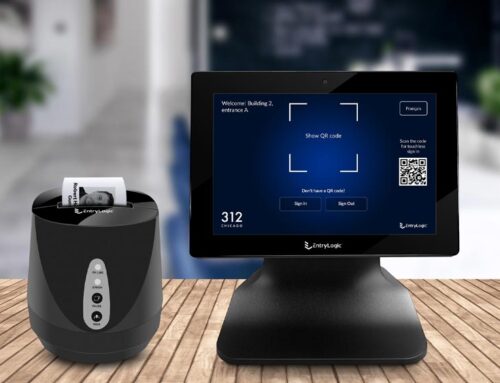As technology advances, offices continue to incorporate more digital tools to help with key processes such as workplace security. Staying ahead of digital trends will be more important as more software gets brought into the workplace. Falling behind on trends can be costly for your company as processes become inefficient, weaknesses in your security become apparent, and you fall behind the competition who does adopt new tools as they become available.
Adopting new technologies will become especially important as security tools and threats continue to evolve. Tools to protect your workplace, employees, and data are already shifting to prioritize cybersecurity and data concerns. As new tech becomes available to protect your assets, tech with more malicious intentions will also grow. Now is the time to look ahead and anticipate the future of workplace security so you can be prepared for any changes. Specifically, biometric security will become a bigger concern in the next few years. Here’s everything you need to know about biometric security to prepare your workplace for the future.
What is Biometric Workplace Security?
Biometric security is the use of biometric data and technology for security purposes. With biometric security, systems are able to capture biometric data and compare it to existing records to verify an individual’s identity.
Biometric data is unique to each person, meaning it is a way to identify people without needing anything extra, like keys or an ID card. It also encompasses many potential data points, some of which are more reliable or easier to capture depending on needs. Biometric data includes two different types of data:
- Biological: Any identifiers that are a result of DNA, like fingerprints, irises, and face structure.
- Behavioral: Any identifiers that are characteristic of a person, like speech patterns, handwriting, or how someone walks.
Since there are many types of biometric data available and methods to capture them, biometric security covers many different options for protecting a workplace. While biometric security is fairly new to the workplace, it is generally more reliable than analog methods.
Benefits of Biometric Security
- Reliable: Biometric systems rely on complex computer programs that can identify and match biometric data to existing records, whereas analog identification methods rely on humans. With a consistent computer program running identifications, there is less room for error.
- Accurate: Depending on which biometric data points a system captures, people can be accurately identified by complex computer programs. Additionally, since biometric security can rely on multiple biometric data points, like both a fingerprint scan and signature capture, there are opportunities to ensure identifications are as accurate as possible.
- Secure: Unlike passwords or key fobs, biometric security systems are harder to trick with copies, guesses, or impersonations. There is an added layer of security when the “password” is the person itself and their biological or behavioral characteristics.
- Always on hand: Similarly, there is less room for human error with biometric systems. There are no more lost keys or missing ID cards since the person themselves acts as the key.
Drawbacks of Biometric Security
- Legality: Depending on where your company operates, you may have trouble determining the best way to comply with biometric data regulations. In the U.S., there isn’t a federal law specific to biometric data collection and storage, so it falls under any general data regulations. Since it can be such a legal gray area, it might be worth investing in legal assistance to help you navigate the ins and outs of the legal implications.
- Data security: Since biometric data tends to be more sensitive than typical security data (like passwords), you’ll need to make sure you protect your biometric data. Unlike passwords and keys that can be reset or replaced, once biometric data is compromised it’s difficult to recover or restore it. If a fingerprint has been compromised, you can’t get someone a new finger.
- Cost: As an emerging technology for the private sector, devices that capture biometric data and software that uses it for identification are still fairly expensive. Especially for small companies, the cost might not be worth the added security that biometric security systems can provide.
How Will Biometrics Impact Workplace Security?
In the coming years biometric security will rise in popularity as technology continues to play a large role in the workplace. Here’s a few ways biometrics could be a better way to protect your company’s assets in the future.
Improve Overall Workplace Security
Biometric security is unique because it relies on individual characteristics that are difficult to copy or fake. The nature of biometric data makes it a more reliable solution that is generally more secure than analog systems. With biometric data like fingerprints, iris scans, and voice recognition, you get an added layer of security that can be applied almost anywhere in your office that’s equipped with a capturing device.
You can continue to monitor the flow of people coming and going from your office, as well as create smaller checkpoints throughout your organization. Biometric security can be used like two-factor authentication on many devices to ensure that whoever is accessing a conference room, a shared computer, or even a break room has the necessary permissions and clearances. With the increasing popularity of biometric authentication in consumer devices like smartphones, laptops, and tablets, more and more devices will be able to capture biometric data, making it easy to incorporate across your organization in the future.
Biometric data can also help you shore up your security and close loopholes for hackers. As technology advances, there are more ways to protect your employees and your sensitive information. But, as old technology becomes outdated even faster, hackers have opportunities to breach your old security systems. Adapting with changing technologies can give you the best chances of staying ahead of cybersecurity threats. In the case of biometric security, you’ll be switching to a more secure form of identity verification to help you protect your assets. Instead of using a password that can be guessed or written down and misplaced, your voice can’t get stolen.
Reevaluate Privacy and Security Concerns
Privacy concerns are on the rise across industries as more organizations collect and sell data. As big players like Google and Facebook make attempts to move away from invasive online trackers like cookies, more companies will follow suit. It also means that your owned first-party data will become more precious than ever. Protecting your assets and your employee data will become increasingly important in the next few years.
Biometric security is uniquely positioned to help you manage your digital assets and limit access to your data. As a more secure method of verification, you can protect any customer or employee information you have and ensure it stays within your control. Plus, you can leverage biometric security to limit internal access to any important data by granting specific permissions to departments or seniority levels.
On the other hand, using biometric technology could also be a hindrance as attitudes toward data collection, particularly data as sensitive as biometric information, have the potential to shift. Biometric data needs to be protected and while there are safer ways to store the information, like using biometric scanning devices that host data locally instead of on a cloud there are always risks involved with collecting sensitive information. Being smart about which biometric security solutions you implement and how they handle data will become an important part of biometric security in the workplace.
Manage Visitors and Secure Workplaces
Biometric security doesn’t just benefit your employees. It can improve the safety of your entire workplace by verifying everyone who goes through your doors. When properly collected and stored, biometric data can add an extra layer of security to your workplace for all the reasons listed above. However, anyone interacting with your system would need to be notified of the biometric data collection and how it will be used.
Once you establish your visitor and data policies, biometric security can streamline the visitor process. Systems make it easy to verify repeat visitors to ensure everyone has proper clearance to your workplace. It can also help you verify the identities of first-time visitors when you capture data, like a signature or photo, that can be compared with an acceptable form of identification.
With the added efficiency of biometric systems, you can easily process visitors quickly without risking your office’s security. Plus, these systems can streamline your reception desk and free up time for your receptionists and security staff to tackle more important tasks. These low-maintenance security systems will become more essential as the nature of work evolves, which brings us to our last point.
Support the Transition to Hybrid and Remote Work
As it becomes clearer that hybrid and fully remote work are here to stay, finding ways to secure both in-person and remote offices will become a major focus for companies. When it comes to securing a physical office, biometric security can help you ensure that only employees and authorized visitors are entering your workplace, no matter where you’re working from. As technology evolves, biometric systems should be able to operate with less oversight than current security teams and reception desks. That means no more need for 24/7 staffing to help verify employees or help with lost keycards.
Biometric security can also help you manage the flux of people in your office. As your employees come into the office some days or work remotely others, biometric systems can help you have oversight on who’s in the office and who isn’t. They can also help manage common areas like offices or meeting rooms to ensure the right people are accessing spaces. They could even help verify meeting hosts who reserve conference rooms and ensure each booked space is used by its intended hosts. As biometric security capabilities expand, there will be many opportunities for them to support hybrid work and provide oversight for leadership teams, whether they’re in the office or not.
***
As a more secure and more foolproof solution to security concerns, biometric data is primed to dominate security technology in the near future. Whether you’re interested in taking your security solution to the next level or creating a workplace primed for hybrid work, it will be important to keep an eye on how biometric security systems evolve over the next few years.







Leave A Comment